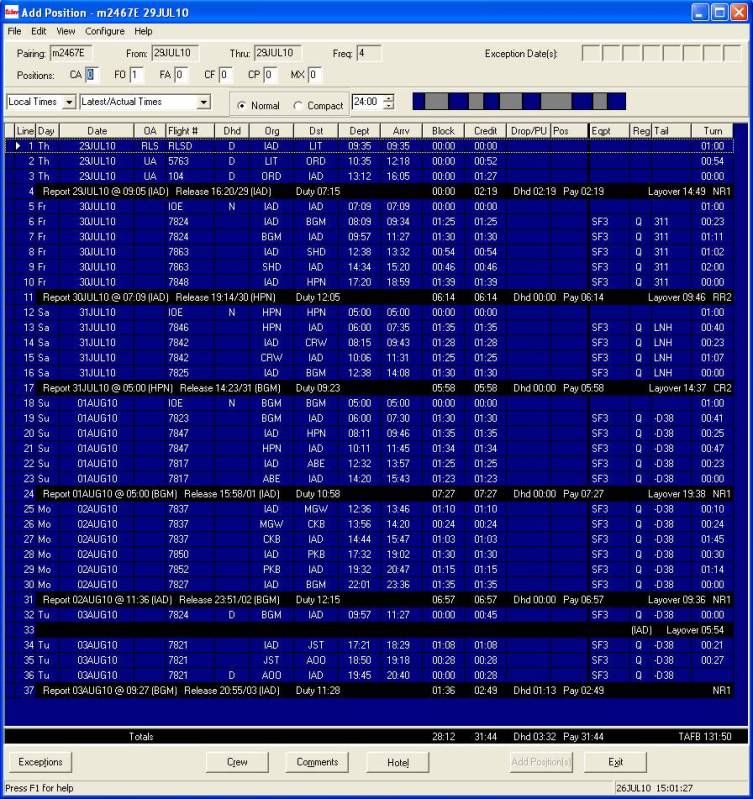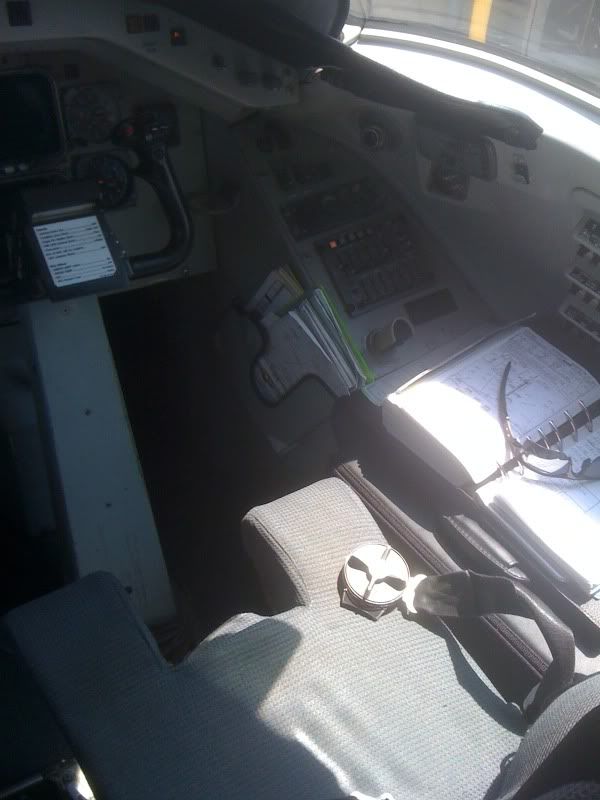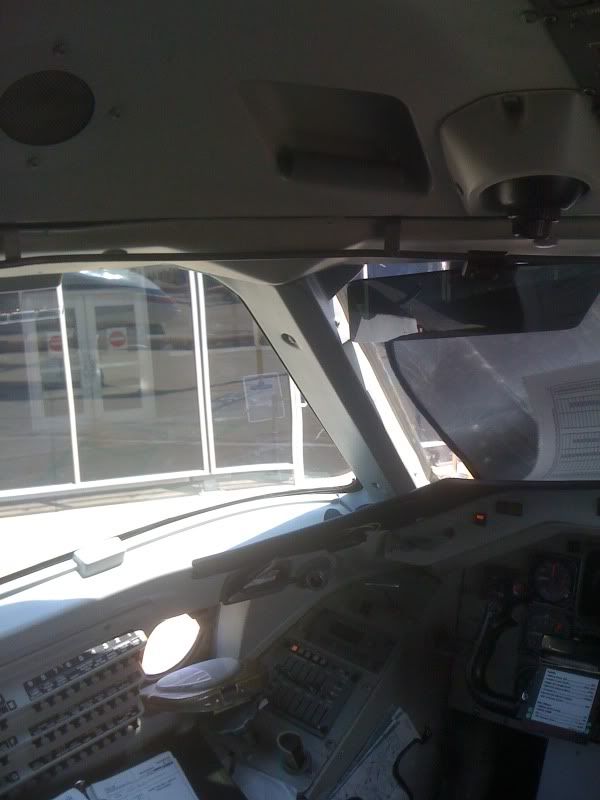As a professional pilot I hold certain responsibilities. Professional pilots have an obligation to ensure the safety of the public through obtaining a high degree of skill and forming sound judgment. We also have a responsibility to other professional pilots who depend on us to follow established practices and policies. Every crew member aboard depends on each other also. We must all have sound leadership skills and form a solid, cohesive, team. This does not mean each crew member must be a leader, but rather possess core traits of a leader. These traits can be learned, but without them the result is nothing short of what can be described as a "sloppy" crew member. This is one reason why former military personnel make great crew members aboard commercial aircraft. Not all former military personnel become pilots, but even their presence in the cabin can have a direct impact on an entire crew if they possess the core leadership traits.
We also have a responsibility to our companies. Obviously they have entrusted us with the responsibilities associated with the safe conduct of flight, but it does not stop there. Just as the police are the first form of governmental contact the public has, crew members are the first form of contact the flying public has with company management. No, we are not the managers of the company, but as pilots we do accept the responsibility to uphold and make decisions which are in the best interest of our company's management team. The direct impact we have on passengers lives is a responsibility we do not downplay. We recognize the reasons passengers are flying. I have often thought of an airport as the only place in the world where you can stand in a terminal and see people walking by who represent every emotional state a human can be in. From the trajic to the happiest of times, not even a hospital can match the diversity of emotional and social reasons why people are there.
What that all means to me is that I have an obligation to my family, passengers, company, and fellow crew members to always observe the highest level of standards possible, never allow myself to be emotionally or physically compromised prior to accepting any flight, maintain the highest level of knowledge and proficiency, and never let any personal needs come before that of my duties and responsibilities as a crewmember.
These are the things that make us who we are. These are the things that drive myself to never settle for anything less than my personal best. Of all the things I have tried to describe, I know I cannot do adequate justice to what this job is all about, but to sum it up with the simple truth: Unhappily, I possess neither that eloquence of diction, that poetry of imagination, nor that brilliance of metaphor to tell you all that they mean to me.
Welcome to my Blog
I am starting this blog just as I am starting my airline career. Feel free to ask any questions, or if you are in need of any help related to seeking employment with an airline then just let me know. I really enjoy helping others in any way that I can.
This is my blog with a name that stems from a long standing joke. Damnit Bobby was a term thrown out during a fun family sports match. Damnit Bobby Airlines was destined to be a loving name given to any flight I conduct which has passengers on board
I was a flight instructor and a part 91 (private carriage) pilot prior to becoming employed with an airline. Please enjoy the blog, and feel free to comment about anything and everything.
This is my blog with a name that stems from a long standing joke. Damnit Bobby was a term thrown out during a fun family sports match. Damnit Bobby Airlines was destined to be a loving name given to any flight I conduct which has passengers on board
I was a flight instructor and a part 91 (private carriage) pilot prior to becoming employed with an airline. Please enjoy the blog, and feel free to comment about anything and everything.
Tuesday, May 24, 2011
Monday, May 2, 2011
Aniversary
Well, it has been a full year since I first received an invitation to an interview. Every day has brought new experiences, challenges, and even new friendships. Flying for the general public has been, and continues to bring great joy to this pilot. The first day was fun and exciting. After going through 4, 2 hour simulator sessions and a PC (Proficiency Check - explained below) I found myself in the beautiful Northeast. My first flight was from Dulles International to Binghamton, NY. Boy! Did we ever hit the ground running. Here is a copy of my first week of IOE (Initial Operating Experience)

That was obviously a fun week, and it was with it's maintenance issues, scheduling conflicts, and passenger issues. I experienced my first medical emergency on my third day. The first time to step in the cockpit (other than the simulator) gave me the same feeling as when I completed a checkride. You spend a lot of time studying, training, and then you get to see the real deal. Definitely a rush. I couldn't help but take a few pictures of my first time in the plane - just as I have always done.


With some of my downtime, and new travel privileges, I enjoyed a week of downtime by visiting the aviation holy land:


Once I finished my IOE, I was given 5 GDO's (Guaranteed Day's off). If you are going to move to your base, these are the days you do it. If you're going to commute, as I continue to do, these are your days to get you SIDA badge - Company "V" file, send in your IOE paperwork, ect... or you can sit on your a$$. They are your vacation days that you earn during your first year.
Once in Houston, I was given a build-up line for my first month off of IOE. A build-up line involves taking flights (we call them trips) that are in open time and assigning them to you so you have a complete schedule for the month. Open time is just as it sounds - unassigned flights. After the first month I was fortunate enough to become a line holder. A line holder is someone who has enough seniority to bid for available schedules, and be awarded one. A reserve pilot is one who can not "hold" a regular line (think of it as a normal schedule). A reserve pilot will be assigned trips on an as needed basis. This may be to fill open time, fill in for a sick pilot, fill in for one who is taking vacation, ect...
Since starting with my first line in August, I have been flying as much as regulations permit. With all times included, I have reached the company time requirements for upgrade to Captain. Right now I am just waiting for the award (as we call it). The schedules I choose are normally afternoons. The time we are supposed to report for duty is called our "Show Time", for obvious reasons. Nevertheless, since I live in Arkansas and fly in Texas I try to find "commutable" lines. These are the lines (schedules) that start late on the first day and finish early on the last day. This gives you the chance to fly in to work on your first day, and fly home on the same day you finish work. Thanks to the kind pilots at ExpressJet, I have had a fairly easy commute.
So that has pretty much been my first year. I've shared some of my experiences in other posts both on here and on the AOPA forums, so no need to be redundant. Just to finish this post off. In case you ever wondered what our training was like, here is a short synopsis.
All new hires go to Training Center at MEM (Memphis International Airport). They put us up in a nearby hotel where we lived for roughly six weeks. Because Memphis is so close, I went home most weekends. Then we were randomly paired together with our classmates. There were 10 in my class (one of the smallest they had). Each pair of students went to simulator training facilities in Houston (Hobby) or St. Louis. I was again fortunate to go to St. Louis as my oldest sister lives about 3 miles from Lambert Field. There we spent a week going through a very structured syllabus. The instructor's had enough freedom to add challenges and ensure you always stayed one step behind the plane. Doing so requires you either adapt and quickly learn to keep pace with the new plane, or you go home. No one in my class failed (all but 4 are now in Houston with me). At the end of simulator training, you are either flown to the other simulator facility or a different sim instructor is flown in to your current sim facility. This instructor gives you a proficiency check, and for us that is the same as a checkride. We officially refere to them as jeopardy training events, since two TP's (train to proficiency) result in a failed checkride... and a failed checkride results in termination. To expound on TP's a little more... Should you not follow company procedures for specific things (say configuring the airplane during a single engine circling approach) the sim instructor must pause the PC and provide immediate remedial training. One more chance to get things right or you are done. After the PC, the training department releases you to the line. Yes, that is yet another use for that term, LOL. A line pilot is simply a pilot who is flying in the field, as opposed to being a management pilot (such as a training director).
Once on the line, you are current for 1 year. At the end of that year you must go back to the simulator for another PC. Several companies, mine included, require that pilots go back to the simulator every 6 months. When this is not a PC the sim session is a PT (proficiency training). A PT is a really great idea, because it is the same as if a pilot from a local GA airport had an instructor go fly with them to identify any weaknesses and/or just improve upon skills.
I hope you enjoyed that or at least enjoyed the little insight into training. As always if you have any questions please feel free to ask. If I don't know the answer, I will definitely find out.
Have a great one,
Bob

That was obviously a fun week, and it was with it's maintenance issues, scheduling conflicts, and passenger issues. I experienced my first medical emergency on my third day. The first time to step in the cockpit (other than the simulator) gave me the same feeling as when I completed a checkride. You spend a lot of time studying, training, and then you get to see the real deal. Definitely a rush. I couldn't help but take a few pictures of my first time in the plane - just as I have always done.


With some of my downtime, and new travel privileges, I enjoyed a week of downtime by visiting the aviation holy land:


Once I finished my IOE, I was given 5 GDO's (Guaranteed Day's off). If you are going to move to your base, these are the days you do it. If you're going to commute, as I continue to do, these are your days to get you SIDA badge - Company "V" file, send in your IOE paperwork, ect... or you can sit on your a$$. They are your vacation days that you earn during your first year.
Once in Houston, I was given a build-up line for my first month off of IOE. A build-up line involves taking flights (we call them trips) that are in open time and assigning them to you so you have a complete schedule for the month. Open time is just as it sounds - unassigned flights. After the first month I was fortunate enough to become a line holder. A line holder is someone who has enough seniority to bid for available schedules, and be awarded one. A reserve pilot is one who can not "hold" a regular line (think of it as a normal schedule). A reserve pilot will be assigned trips on an as needed basis. This may be to fill open time, fill in for a sick pilot, fill in for one who is taking vacation, ect...
Since starting with my first line in August, I have been flying as much as regulations permit. With all times included, I have reached the company time requirements for upgrade to Captain. Right now I am just waiting for the award (as we call it). The schedules I choose are normally afternoons. The time we are supposed to report for duty is called our "Show Time", for obvious reasons. Nevertheless, since I live in Arkansas and fly in Texas I try to find "commutable" lines. These are the lines (schedules) that start late on the first day and finish early on the last day. This gives you the chance to fly in to work on your first day, and fly home on the same day you finish work. Thanks to the kind pilots at ExpressJet, I have had a fairly easy commute.
So that has pretty much been my first year. I've shared some of my experiences in other posts both on here and on the AOPA forums, so no need to be redundant. Just to finish this post off. In case you ever wondered what our training was like, here is a short synopsis.
All new hires go to Training Center at MEM (Memphis International Airport). They put us up in a nearby hotel where we lived for roughly six weeks. Because Memphis is so close, I went home most weekends. Then we were randomly paired together with our classmates. There were 10 in my class (one of the smallest they had). Each pair of students went to simulator training facilities in Houston (Hobby) or St. Louis. I was again fortunate to go to St. Louis as my oldest sister lives about 3 miles from Lambert Field. There we spent a week going through a very structured syllabus. The instructor's had enough freedom to add challenges and ensure you always stayed one step behind the plane. Doing so requires you either adapt and quickly learn to keep pace with the new plane, or you go home. No one in my class failed (all but 4 are now in Houston with me). At the end of simulator training, you are either flown to the other simulator facility or a different sim instructor is flown in to your current sim facility. This instructor gives you a proficiency check, and for us that is the same as a checkride. We officially refere to them as jeopardy training events, since two TP's (train to proficiency) result in a failed checkride... and a failed checkride results in termination. To expound on TP's a little more... Should you not follow company procedures for specific things (say configuring the airplane during a single engine circling approach) the sim instructor must pause the PC and provide immediate remedial training. One more chance to get things right or you are done. After the PC, the training department releases you to the line. Yes, that is yet another use for that term, LOL. A line pilot is simply a pilot who is flying in the field, as opposed to being a management pilot (such as a training director).
Once on the line, you are current for 1 year. At the end of that year you must go back to the simulator for another PC. Several companies, mine included, require that pilots go back to the simulator every 6 months. When this is not a PC the sim session is a PT (proficiency training). A PT is a really great idea, because it is the same as if a pilot from a local GA airport had an instructor go fly with them to identify any weaknesses and/or just improve upon skills.
I hope you enjoyed that or at least enjoyed the little insight into training. As always if you have any questions please feel free to ask. If I don't know the answer, I will definitely find out.
Have a great one,
Bob
Subscribe to:
Posts (Atom)